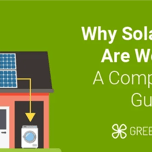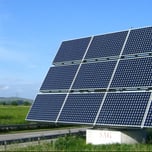- GreenMatch
- Blog
- UK Solar Capacity
The UK's Solar Capacity Explained (October 2025)
Insights & Projections of UK Solar Power Growth
Astonishingly, the solar capacity in the UK had increased from 5,488.6 MW in 2014 to 13,259 MW in June 2019. On top of that, the UK’s maximum net generating solar capacity was 13.1 GW in 2018, which placed it at the 3rd position among the other EU member states.
Moreover, since the launch of the Feed-in Tariff in the UK in April 2010, there were 992,065 new solar panel installations for the period it was active. However, new changes in the legislation for PV systems have been introduced by the British government.
Some of the most important changes include the closure of the Feed-in Tariff, and the introduction of the Smart Export Guarantee (SEG), which provides financial support to small low-carbon generators. Another new revision concerns the increase of the VAT on photovoltaic installations that may slow down the solar capacity growth in the UK.
The Feed-in Tariff ended in the UK in April 2019. The reason for this is that the renewable technologies covered by the scheme have become more affordable, and thus more widely accessible.
In order to answer all of your questions and present you with the bigger picture, GreenMatch has created an infographic about the UK’s solar capacity, as well as future projections and targets for solar power growth:

If you would like to use this infographic on your website, use the embed code below:
Will the EU Member States Reach Their 2020 Targets for Renewable Energy?
In the EU, the maximum net generating solar capacity was estimated to be 171 GW for 2018, with the top 3 countries being:
- 1st place - Germany with 45.9 GW,
- 2nd place - Italy with 20.1 GW,
- 3rd place - the UK with 13.1 GW.
Overall, 2018 had been a very successful year for the European solar market with 21% annual increase in solar installations and 11.3 GW solar power being added. Furthermore, the demand for solar power in the European Union rose by 37%, which could be related to the approaching final of the 2020 EU targets for renewable energy.
Furthermore, according to a recent Eurostat official update, 11 EU member states have already reached their 2020 renewable energy targets. Some of them include: Italy, Croatia, Sweden, Denmark, Finland, Bulgaria and the Czech Republic.
Unfortunately, some of the other members are quite far from reaching their goals and may even miss it. For example, France is falling behind with 6.7 pp, Ireland with 5.3 pp and the United Kingdom with 4.8 pp.
An Overview of Renewable Energy Sources in the UK
In the United Kingdom, the total renewables share of energy generation in 2018 was 33%, which accounts for an increase of 3.8% compared to the previous year. The biggest share went with onshore and offshore wind power, which combined comprise 17.1%. On the second place was bioenergy with 10.4% and third, solar energy with 3.9%.
If we take a closer look at each renewable energy source individually, we can distinguish the following trends:
- Onshore wind - 5,2% growth in 2018 compared to the previous year;
- Offshore wind - 27.6% growth in 2018 compared to the previous year;
- Solar energy - 14.6% growth in 2018 compared to the previous year;
- Hydro power - 12% growth in 2018 compared to the previous year;
More specifically, the UK’s solar market is dominated by small-scale PV systems which comprise more than 90% of the total 1,007,427 installations. Only in June this year, there have been 2,375 confirmed new sub-4kW solar system installations, while there was no change in the numbers for large scale photovoltaic systems.
UK's Solar Prospects for 2025
Even though it hasn't always been blue skies and sunshine, it looks like the UK's future solar prospects are bright.
For example, the UK's cumulative capacity reached 17.6 GW by the end of 2023. This is set to continue for 2024 with the UK solar capacity expected to increase by more than 2 GW. Hence, the UK's solar future may not be so dark after all.
We strive to connect our customers with the right product and supplier. Would you like to be part of GreenMatch?





